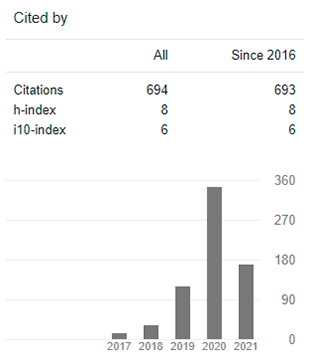The Cyberculture as a tool to build contemporary, real and virtual worlds
DOI:
https://doi.org/10.29394/Scientific.issn.2542-2987.2018.3.10.18.317-329Keywords:
multimedia instruction, digital art, educationAbstract
The purpose of this essay after the analysis of the ideas formulated by different authors mentioned throughout the text, is to show the scientific community and interested in the subject, analyze their concern about the Cyberculture as a tool to build contemporary worlds, real and virtual The processing of the information was treated with a view to supporting the analysis of the theoretical sketches belonging to the Cyberculture as a way of sharing knowledge, from a real and virtual contemporary world to modify the ways of disturbing, proceeding and knowing in reality social transfer to the curricular articulation. It is concluded that the theoretical applications must be analyzed from the pedagogical practices with the idea of revaluing the use and use of technological tools in the teaching-learning process, in the search of optimizing the quality of training at all levels and modalities of the Venezuelan educational system.
Downloads
References
Barberá, E. (Coord.) (2001). La Incógnita de la Educación a Distancia. Cuadernos de Educación ICE. España: Universitat de Barcelona, Horsori Editorial.
Baym, N. (2002). Interpersonal Life Online. In S. Livingston & L. Lievrouw (eds.). The Handbook of New Media. London: SAGE Publications Ltd.
Cabero, J., & Gisbert, M. (2005): La Formación en Internet. Guía para el Diseño de Materiales Formativos. Sevilla, España: MAD.
Cáceres, J. (1998). Cibercultura, Ciberciudad, Cibersociedad hacia la Construcción de Mundos Posibles en nuevas Metáforas Conceptuales. Estudios sobre las Culturas Contemporáneas, IV(7), 9-23. Recuperado de: http://www.redalyc.org/articulo.oa?id=31600702
Caridad, M., & Moscoso, P. (1991). Los Sistemas de Hipertexto e Hipermedios: Una Nueva Aplicación en Informática Documental. Madrid, España: Fundación Germán Sánchez Ruipérez.
Escobar, A. (2005). Bienvenidos a la Cyberia. Notas para una Antropología de la Cibercultura. Revista de Estudios Sociales, (22), 15-35. Recuperado de: https://revistas.uniandes.edu.co/doi/abs/10.7440/res22.2005.01
Lévy, P. (1999a,b). Ciberespacio y Cibercultura. Barcelona, España: Universitat Oberta de Catalunya.
Martínez, O. (2016). Programa de Formación Docente de las Tecnologías del Aprendizaje y el Conocimiento (TAC) En la Universidad Pedagógica Experimental Libertador Núcleo Barinas (Venezuela). Revista Scientific, 1(1), 90-114. Recuperado de: https://doi.org/10.29394/scientific.issn.2542-2987.2016.1.1.6.90-114
Rodríguez, J. (2007). La crítica hoy: De los retos de la posmodernidad a los retos de la Cibercultura. Ponencia presentada en el Encuentro de crítica: perspectivas y problemas de la crítica literaria en el siglo XXI. Bogotá, Colombia: Universidad Nacional de Colombia. Recuperado de: http://cmap.javeriana.edu.co/servlet/SBReadResourceServlet?rid=1264424851592_1898921882_1618
Rubio, M., & Romero, L. (2005). Apostar por la Calidad de la Educación Superior a Distancia desde la Pertinencia Social. Ecuador: Universidad Técnica Particular de Loja.
Salas, Y. (2013). Cibercultura y Educación. Diá-logos (San Salvador), 7(11), 29-43, ISSN: 1996-1642. Recuperado de: http://rd.udb.edu.sv
Published
How to Cite
Issue
Section
License
Copyright (c) 2018 INDTEC, C.A.

This work is licensed under a Creative Commons Attribution-NonCommercial-ShareAlike 4.0 International License.
The content of the journals of this site, are under a Creative Commons Attribution-Noncommercial-Share Alike 4.0 International License.













